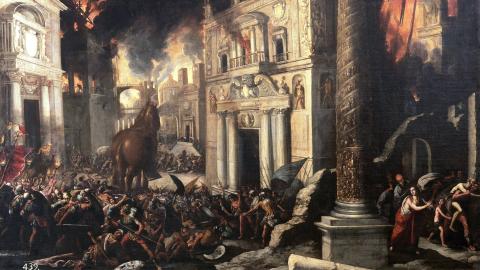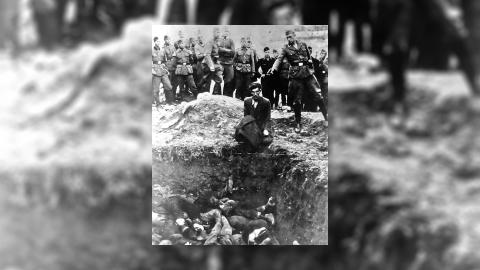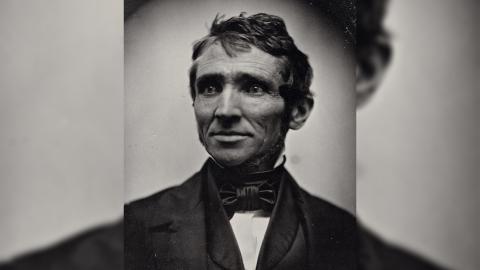Meet Marina Amaral a historical colourist
The man in the photograph cuts a striking figure. From his thick brow to his stiff chin, the 51-year-old holds himself with confidence. His pose is strong and his blue eyes piercing.
But this image of Abraham Lincoln - taken four months before his election victory in 1860 - is not the original. That was taken by Alexander Hesler in black and white while this is in colour, something that wasn’t widely used until the 20th Century. So, what are we looking at?
This is a colourised image by the self-taught artist Marina Amaral. This photo of Lincoln is a perfect example of her work, which takes some of the most iconic black and white photos and reimagines them in vibrant colour. Along with Lincoln, she has colourised various moments and people in history such as Jackie Kennedy, Winston Churchill and Lee Harvey Oswald and the results are stunning.
Marina Amaral is a historical digital colourist, something which matches her passion for the subject and for HISTORY itself, as she tells us, "When I'm working on my pictures I watch HISTORY documentaries all the time. It’s something that helps me keep focused on my work and entertained at the same time. I'm a really big fan.”
We caught up with Marina, who’s based in Brazil, to find out more about how she works, what the images mean to her and how she became a colourist.
Words from Marina Amaral:
“It was not planned, it was kind of random. I was studying International Relations, I had a blog and I needed to create a coloured image. I spent hours watching tutorials on YouTube trying to understand the software and the tools. Then in 2015 I discovered some colourised photographs of the Second World War and I immediately knew I wanted to create something similar. I said to myself that I was going to give it a try and I began to practice literally every day.
"The first picture I completed was of an American Civil War soldier. I was so proud when I finished that photo, but today I look at it and I just think it's terrible. I will never post this image online, it's just awful!
"At the beginning, I was so scared to try something more ambitious. It took a long time for me to move from portraits to more complex images, but over time as I managed to develop my skills I began to work on larger images and now I can work on photos of various levels of complexity.
"I had to quit college to have time to produce the images. One day I realised that it had become my profession, but I didn’t choose it, I never planned to build a career from this, it was a natural progression. Now this is what I do for a living and I've done around 300 images.
"I pick my images based on my personal interest. for example, I read a lot of Second World War books so I naturally want to see what I read being transformed into a more real perspective. I also get lots of requests on Twitter and Facebook and I do some of those giving my audience the opportunity to see their idols or favourite moment in history in colour.
"It's actually really difficult to find good photos in the public domain, I need to be careful with copyright laws, so that’s a limitation I have. Sometimes I find an image that is amazing and I'm excited to colourise it, but then I see that that photo is not in the public domain and I can't use it.
"When I see a black and white photo I feel that what I'm seeing is not real. Sometimes I feel like the event or the person that I'm seeing is only real in history books and this is not true.
"When you see a photo in colour I think you instantly feel more connected to what you are seeing. All these people in the past, whether good or bad, were human beings just like you and me. I think the colours allow us to build this bridge with the past and to see things from a different perspective and this is exactly what I try to achieve with my work.
"An image can take anywhere from 40 minutes to 14 days. It really depends on the complexity and the process is all manual, everything you see in an image has been selected by hand in Photoshop. It's very time consuming and is not an easy process if you want to achieve a realistic result.
"I start with research for all my images. For example, if I have a Second World War photograph I will start by searching for the original colours of the uniform, the medals, the skin, hair colour, eyes. I try and find modern photographs of the location in the image, visual descriptions that might be available in historical documents. The research part can often take a few days. I can only start the colourisation process once this is done.
"There are some photos that are more difficult to work on not because of the complexity but because of the subject. For example when I'm working on photos from the Holocaust it's very hard. I see the victims and although they are alive in the photos I know what happened to them and It's hard not to think of this when I'm restoring the picture. But, after I’ve finished and I publish and people get the opportunity to see the photo in colour it's worth it. The reaction is always very emotional and this is what I want to do with my work, I want people to feel connected to what they are seeing. I also want to give the person that I'm colourising the opportunity to tell their story.
"It's not easy sometimes I feel headaches, my back hurts or my eyes hurt. But when I hear how people’s perspectives can change after seeing a picture in colour I feel that my job is done.
"I take my job very seriously. I'm aware that I'm working with historical documents and I need to be respectful... I must be sure that I use accurate colours and that I give people the chance to see the historical image to as close as possible to how it really happened.”
If you want to see more of Marina’s fascinating work, follow her on twitter @marinamaral2, visit her website here, or keep up to date with the publication of her brand new book, The Colour of Time, created with historian Dan Jones.
















